| Page last updated
9 December 2010 |
What's New with the MUSSELp?
The highlights of 2010.
 9 December 2010 -- A Successful Term of Sequencing. Graduate student Nathan Whelan and undergraduate Sarah Wofford closed out their first semesters of working in DLG's lab. Toiling as a team in the Laboratory for Invertebrate Systematics at the University of Alabama, these two contributed to the MUSSELp and BivAToL by generating DNA sequences for freshwater mussels from Africa, Australia, South America, and even the United States. The work is ongoing but will eventually contribute to analyses of family-level relationships of freshwater mussels. 9 December 2010 -- A Successful Term of Sequencing. Graduate student Nathan Whelan and undergraduate Sarah Wofford closed out their first semesters of working in DLG's lab. Toiling as a team in the Laboratory for Invertebrate Systematics at the University of Alabama, these two contributed to the MUSSELp and BivAToL by generating DNA sequences for freshwater mussels from Africa, Australia, South America, and even the United States. The work is ongoing but will eventually contribute to analyses of family-level relationships of freshwater mussels.
In November, Nathan presented a preview of our results at the Malacological Society of London's Molluscan Forum at the Natural History Museum. He reported that our poster, "What, if anything, is a unionid? Coelatura Conrad, 1853 and the monophyly of the Unionidae (Bivalvia: Unionoida)," was well received. We are eager to follow up with a publication.
Thanks to Nathan and Sarah for their good work. Watch this space for more student-supported research from the MUSSELp! |
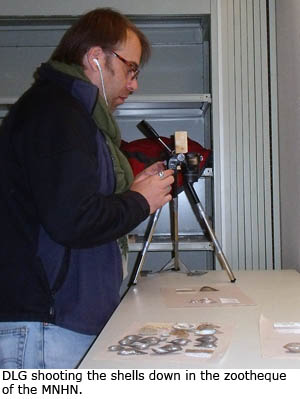 21-27 November 2010 -- Back to the MNHN. DLG took advantage of the long holiday break from teaching to return to Paris. The Muséum National d'Histoire Naturelle has one of the major mollusk collections in the world, including many thousands of freshwater mussel specimens. After four days three floors below the Jardin des Plantes in the zootheque (where the general collection is housed), he came away with more than 800 pictures of mussels from southeastern Asia. 21-27 November 2010 -- Back to the MNHN. DLG took advantage of the long holiday break from teaching to return to Paris. The Muséum National d'Histoire Naturelle has one of the major mollusk collections in the world, including many thousands of freshwater mussel specimens. After four days three floors below the Jardin des Plantes in the zootheque (where the general collection is housed), he came away with more than 800 pictures of mussels from southeastern Asia.
While in town, DLG also took advantage of the fantastic library of the MNHN to continue work on the Locard type specimens.
There is no doubt that we will need to go back to Paris at least once more as part of our effort to document and analyze global freshwater diversity. It's a dirty job, but someone has to do it. |
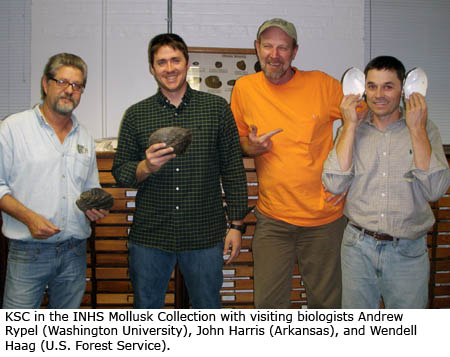 4 November 2010 -- Mussel Potpourii II. KSC and Alison Price gave an invited talk entitled "Interior Basin Freshwater Mussels: Upper Mississippi and Ohio River Drainages" on 20 October 2010 at the Freshwater Mollusk Conservation Society (FMCS) 2010 Workshop – “Regional Fauna Identification and Sampling”. The meeting was held at the Powder Valley Conservation Nature Center, in Kirkwood, Missouri. About 125 people attended the workshop and hopefully left with a better understanding of the nuances of unionid identification. Pdf’s of the presentations will likely be posted on the FMCS website in the not too distant future. Other INHS attendees included Diane Shasteen and Sarah Bales who are working with KSC on a statewide survey of freshwater mussels of Illinois (see 8 March 2010 -- Mussel Potpourii on the What’s New Page for additional details of that project). 4 November 2010 -- Mussel Potpourii II. KSC and Alison Price gave an invited talk entitled "Interior Basin Freshwater Mussels: Upper Mississippi and Ohio River Drainages" on 20 October 2010 at the Freshwater Mollusk Conservation Society (FMCS) 2010 Workshop – “Regional Fauna Identification and Sampling”. The meeting was held at the Powder Valley Conservation Nature Center, in Kirkwood, Missouri. About 125 people attended the workshop and hopefully left with a better understanding of the nuances of unionid identification. Pdf’s of the presentations will likely be posted on the FMCS website in the not too distant future. Other INHS attendees included Diane Shasteen and Sarah Bales who are working with KSC on a statewide survey of freshwater mussels of Illinois (see 8 March 2010 -- Mussel Potpourii on the What’s New Page for additional details of that project).
INHS had three distinguished visitors the week of November 1st. Wendell Haag of the USDA-Forest Service Southern Research Station and Andrew Rypell a post-doc at Washington University in St. Louis. Wendell and Andrew are investigating the effects of climate change on aquatic ecosystems using mussels as indicator species. More specifically, they are working with the growth rings of long-lived species to examine functional impacts of climate on mussels. This is essentially an analogue to tree-ring science (i.e., dendrochronology) applied to freshwater mussels, and aquatic ecosystems. John Harris, Assistant Chief of the Arkansas Highway Department’s Environmental Division and all around good guy, is examining specimens of the fat pocketbook, Potamilus capax, to see if there might be more than one species masquerading under that name. |

|
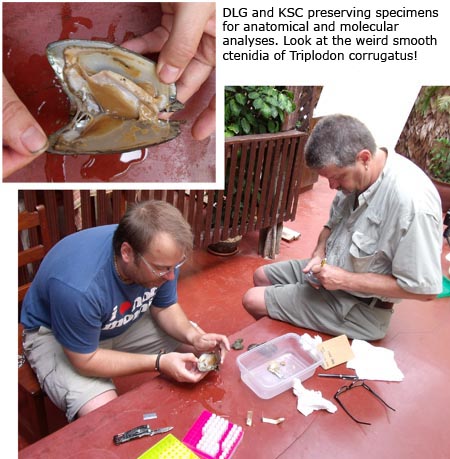 29 July-9 August 2010 -- MUSSELp visits Peru to find elusive freshwater mussels for the BivAToL project. Our crew had a successful trip to collect mussels in the vicinity of Iquitos, Peru on the Amazon River. The primary objective of the trip was to obtain fresh specimens of Neotropical hyriid and mycetopodid mussels and fix them in the proper preservatives for inclusion in the Bivalve Assembling the Tree of Life Project. Mission accomplished! 29 July-9 August 2010 -- MUSSELp visits Peru to find elusive freshwater mussels for the BivAToL project. Our crew had a successful trip to collect mussels in the vicinity of Iquitos, Peru on the Amazon River. The primary objective of the trip was to obtain fresh specimens of Neotropical hyriid and mycetopodid mussels and fix them in the proper preservatives for inclusion in the Bivalve Assembling the Tree of Life Project. Mission accomplished!
Mark Sabaj-Pérez, the ichthyology collection manager at the Academy of Natural Sciences of Philadelphia, was the leader of our expedition, and Dr. Sabaj has a long history of visiting Iquitos on behalf of the MUSSELp. In 2003, we funded him to acquire mussels for us, but he struck out. On his own initiative, Mark went back to Iquitos in 2005 and landed several mycetopodid and hyriid species in the Rio Itaya. Those were fixed in formalin with tissue snips in ethanol for molecular work. However, for those mussels to be of even minimal value to the BivAToL project, we needed those same species in RNAlater. So, we had to go back for another try. We were confident of success this year since, just as in 2005, we were in a La Niña year: we expected the water to be low enough to be able to get to the mussels. Bingo!
 As it seems with any expedition to survey fresh waters, our crew was biased toward ichtyologists.We were joined by Chris Phillips and Jeremy Tiemann of the Illinois Natural History Survey, Brian Sidslauskas of Oregon State University, Cristina Pérez-Sabaj of Friends Central School near Philadelphia, and Vanessa Correa Roldán of the Universidad Nacional Mayor de San Marcos in Lima. This expedition was funded by our various institutions and the National Science Foundation. As it seems with any expedition to survey fresh waters, our crew was biased toward ichtyologists.We were joined by Chris Phillips and Jeremy Tiemann of the Illinois Natural History Survey, Brian Sidslauskas of Oregon State University, Cristina Pérez-Sabaj of Friends Central School near Philadelphia, and Vanessa Correa Roldán of the Universidad Nacional Mayor de San Marcos in Lima. This expedition was funded by our various institutions and the National Science Foundation.
|
| |
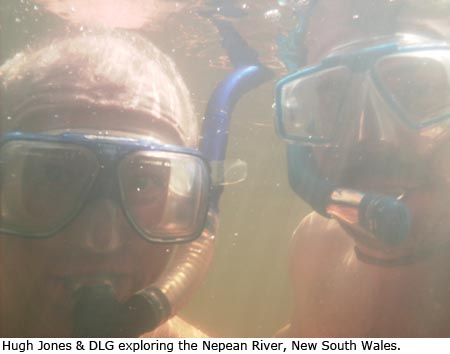 14-20 March 2010 -- The MUSSELp in NSW. DLG and MUSSELp collaborator Hugh Jones spent the Bama Spring Break collecting mussels in southeastern Australia. The primary targets of the expedition were Velesunio ambiguus and Hyridella australis in support of Bivatol (Bivalve Assembling the Tree of Life), but their sampling effort also included various congeners and species of Alathyria and Cucumerunio. The latter will be used to further our understanding of the phylogeny of the Australasian Hyriidae and the relationships of those lineages to the mussels in the Neotropics (and perhaps even Africa!). 14-20 March 2010 -- The MUSSELp in NSW. DLG and MUSSELp collaborator Hugh Jones spent the Bama Spring Break collecting mussels in southeastern Australia. The primary targets of the expedition were Velesunio ambiguus and Hyridella australis in support of Bivatol (Bivalve Assembling the Tree of Life), but their sampling effort also included various congeners and species of Alathyria and Cucumerunio. The latter will be used to further our understanding of the phylogeny of the Australasian Hyriidae and the relationships of those lineages to the mussels in the Neotropics (and perhaps even Africa!).
|
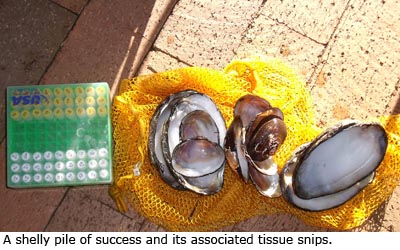 In general, the weather cooperated, although the heavy rains of the previous week left some of the rivers a bit high and turbid. Jones and Graf sampled various sites in the coastal streams from Sydney north, as well as a few interior waterways. Eventually, a map of our sampling sites will be found on this web site. In general, the weather cooperated, although the heavy rains of the previous week left some of the rivers a bit high and turbid. Jones and Graf sampled various sites in the coastal streams from Sydney north, as well as a few interior waterways. Eventually, a map of our sampling sites will be found on this web site.
In addition to furthering Hugh's collaboration with the MUSSELp, DLG used the opportunity of his visit to give an impromptu seminar on freshwater mussel systematics and diversity at the University of Sydney. "Evolution and Diversity of Freshwater Mussels (Mollusca: Bivalvia: Unionoida): Thinking Globally but Acting Locally" pulled together pieces of various recent lectures and provided a broad overview of the goals and accomplishments of the MUSSELp.

DLG and Hugh Jones at their first collecting site, Mammy Johnsons Creek.
|
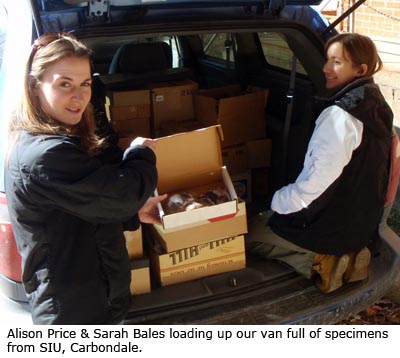 8 March 2010 -- Mussel Potpourii. KSC and his crew at the Illinois Natural History Survey have been busy. Members of the project crew investigating mussel communities in Illinois streams presented a paper at the Illinois Chapter of the American Fisheries Society Meeting at Rend Lake, Illinois 23-25 February 2010. The objective of the Illinois stream project is to collect baseline mussel data in conjunction with existing basin surveys for fishes in wadeable streams in Illinois. The project is part of the Illinois' Wildlife Action Plan, and data collected will support revisions of current mussel community indices, assist water quality initiatives, and guide restoration initiatives in Illinois waters. 8 March 2010 -- Mussel Potpourii. KSC and his crew at the Illinois Natural History Survey have been busy. Members of the project crew investigating mussel communities in Illinois streams presented a paper at the Illinois Chapter of the American Fisheries Society Meeting at Rend Lake, Illinois 23-25 February 2010. The objective of the Illinois stream project is to collect baseline mussel data in conjunction with existing basin surveys for fishes in wadeable streams in Illinois. The project is part of the Illinois' Wildlife Action Plan, and data collected will support revisions of current mussel community indices, assist water quality initiatives, and guide restoration initiatives in Illinois waters.
The paper by Diane Shasteen, Alison Price, and Sarah Bales -- entitled “Muscling (Musseling) Across Illinois: The Good, the Bad and the Clammy” -- was very well received by the meeting attendees. In addition, Alison Price received an award for best paper from last years IL-AFS meeting for her paper “Crouching Sampler, Hidden Fish: The Evaluation of Fish Movement During Sampling in Wadeable Warmwater Streams.
KSC received a lifetime achievement award for his work on Midwestern Mussels from the IL-AFS Chapter in 2008. KSC presented a paper on “Exotic Freshwater and Terrestrial Mollusks in Illinois”, coauthored by Jeremy S. Tiemann and Christopher A. Phillips.
Speaking of exotics and although not a freshwater mussel per se, KSC published a note in late 2009 on the discovery of the mottled fingernail clam, Eupera cubensis in the upper Illinois - Mississippi River drainage. This find was a substantial range expansion for this exotic freshwater bivalve in North America. Check out Sneen et al. (2009) for more information.
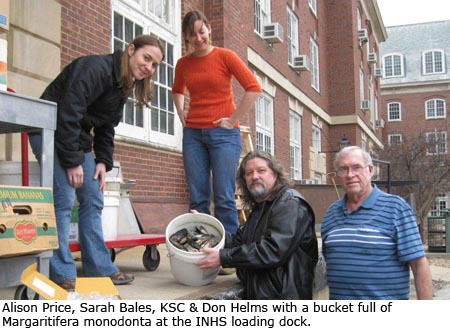 Two fairly large collections were accessioned into the Illinois Natural History (INHS) Mollusk Collection in February and March. The mollusk portion of the invertebrate collection of Joseph A. Beatty (late Professor of Zoology and Curator of Invertebrates at Southern Illinois University, Carbondale) was picked up from SIU-C and transferred to INHS. Included were many specimens from southern Illinois collected by Dr. Beatty’s students over the past 40 years. These specimens will fill in many gaps in our knowledge of freshwater mussel distribution in the state of Illinois. In addition, INHS also accessioned a collection of freshwater mussels collected primarily in the Mississippi River from private consultant Don Helms and crew. This collection contains many interesting specimens including a large series of Margaritifera mondonta, a rare mussel in the Interior Basin. Two fairly large collections were accessioned into the Illinois Natural History (INHS) Mollusk Collection in February and March. The mollusk portion of the invertebrate collection of Joseph A. Beatty (late Professor of Zoology and Curator of Invertebrates at Southern Illinois University, Carbondale) was picked up from SIU-C and transferred to INHS. Included were many specimens from southern Illinois collected by Dr. Beatty’s students over the past 40 years. These specimens will fill in many gaps in our knowledge of freshwater mussel distribution in the state of Illinois. In addition, INHS also accessioned a collection of freshwater mussels collected primarily in the Mississippi River from private consultant Don Helms and crew. This collection contains many interesting specimens including a large series of Margaritifera mondonta, a rare mussel in the Interior Basin.
- M.E. Sneen, K.S. Cummings, T. Minarik Jr., and J. Wasik. 2009. The discovery of the nonindigenous, mottled fingernail clam, Eupera cubensis (Prime, 1865) (Bivalvia: Sphaeriidae) in the Chicago Sanitary and Ship Canal (Illinois River Drainage), Cook County, Illinois. Journal of Great Lakes Research 35(4): 627–629.
|
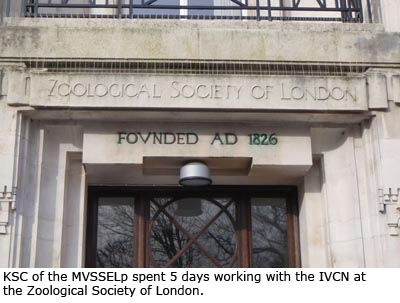 1-5 February 2010. — MUSSELp at the IUCN in London. KSC attended the IUCN (International Union for the Conservation of Nature) Red List workshop to assess the Red List (endangered) status of the world’s freshwater mollusks. The meeting was held at the Zoological Society of London head office, in Regent’s Park, London, UK, 1-5 February 2010. The workshop was organized jointly by the Zoological Society of London, the Encyclopedia of Life and the IUCN SSC Mollusk Specialist Group. 1-5 February 2010. — MUSSELp at the IUCN in London. KSC attended the IUCN (International Union for the Conservation of Nature) Red List workshop to assess the Red List (endangered) status of the world’s freshwater mollusks. The meeting was held at the Zoological Society of London head office, in Regent’s Park, London, UK, 1-5 February 2010. The workshop was organized jointly by the Zoological Society of London, the Encyclopedia of Life and the IUCN SSC Mollusk Specialist Group.
The aim of the five-day workshop was to bring together regional and international scientific experts to assess the conservation status for approximately 900 species of freshwater mollusks from around the world. Results in the form of Red List Assessments from this important workshop will provide much needed information for freshwater conservation efforts, and will be incorporated into the Convention on Biological Diversity indicator, the Red List Index. Results will be made publicly available on the IUCN Red List of Threatened Species and via Encyclopedia of Life species pages.
KSC would like to thank Nadia Dewhurst (ZSL) and her wonderful staff (Gita, Moni, Elle, Felix, Sean and others) for the gracious invitation and assistance at the workshop and to Amy Burden (IUCN) for playing the role of Goodwill Ambassador to many of the yanks visiting London that week. |
|